F-5E Photo Lightning
Trumpeter 1/32 P-38L with Jerry Rutman's resin F-5E conversion.
Here's the best story I know about a photo-Lightning mission:
The Loire River Death Ride of “Chili” Childress:
One of the most hair‑raising missions ever flown by the 7th Photo Group occurred when Major Hubert "Chili" Childress, Commanding Officer of the 27th Photo Squadron ‑ the last unit to arrive at Mount Farm in January 1944 ‑ was handed orders for a mission completely unlike anything he had flown in his six months of operations in the E.T.O.
"SHAEF wanted pictures of all the Loire River bridges, so they knew how they were made, because they wanted to blow them up to keep the German forces south of the Loire from crossing into northern France after the invasion. That meant going in at low level. We decided that we should fly the mission at a maximum altitude of 50 feet to stay below the treeline in our approaches to the bridges. In fact, I flew most of the mission at an altitude of 30 to 40 feet." Knowing the importance and danger of the mission, Childress assigned himself the flight.
Because of the fact the F‑5 did not have a forward‑facing camera, Childress would be forced to make his photo runs parallel to the bridges, crossing back and forth across the river. “I had to fly straight and level, at a maximum speed of 320 mph, a minimum of 200 yards from the bridge to get the pictures.” Such a mission parameter put the F-5 at the optimum distance for defending flak. A second P‑38 from the 13th Squadron was detailed to follow Childress. "He was there to take over after I got shot down," Childress recalled. “I figured I might make it for four bridges before that happened.” Since the Germans would be surprised at the first bridge but fully warned and prepared as the mission went on, it was deemed so dangerous that - like Childress - the 13th Photo Squadron's C.O. assigned himself to the mission, being unwilling to risk the lives of any other of his pilots.
The mission was also different in that it would be the first flown by the 7th Photo Group to receive fighter escort. "We had 16 P‑38s from the 55th Fighter Group that met us over Cherbourg," Childress explained. "Four flew with me to provide flak suppression, four were with the other F‑5, and the other 8 were there to keep any German fighters that showed up off our backs."
There were a total of 64 bridges across the Loire that had to be photographed. By staying low, the Lightnings would only exposed to enemy flak during the few seconds they were directly over the bridges. By varying the direction they approached from, they were able to maintain the element of surprise as they took shots of the first 50 bridges.
"We took hits, but nothing serious, though every time I went past a bridge and saw all that flak coming up I figured I was taking a year off my life. When we got to Tours, there were four bridges inside the town, and we could only circle and head back and forth between them while staying directly over the city, which meant they could shoot at us continuously. The second and third bridges were so close together that when I was photographing one, I was directly over the other. That was where I got hit, over the third bridge. I felt a thump, but everything seemed to continue working, so I got pictures of the last bridge and then we were out of there. As I was flying along the river to the next target, the escort leader called on the radio and told me I was trailing smoke from the left engine. I looked out and sure enough, the cowling had a few holes in it and smoke was pouring out of the turbo. I feathered the prop and called to Major Smith that he'd have to get the rest of the bridges. I started climbing for altitude to get above the light flak, and managed to get it up to 10,000 feet by the time we got to the Channel."
Once back at Mount Farm, Childress performed the standard entry maneuver for landing, an overhead‑360 to the left, into the dead engine. "I'd always been told never to turn a Lightning into the dead engine, but the airplane was running so well no one on the ground even realized I was only on one engine. I landed, but then I couldn't turn left off the runway, so they had to come out and tow me back in. The airplane had enough holes in it that it didn't fly again for about ten days."
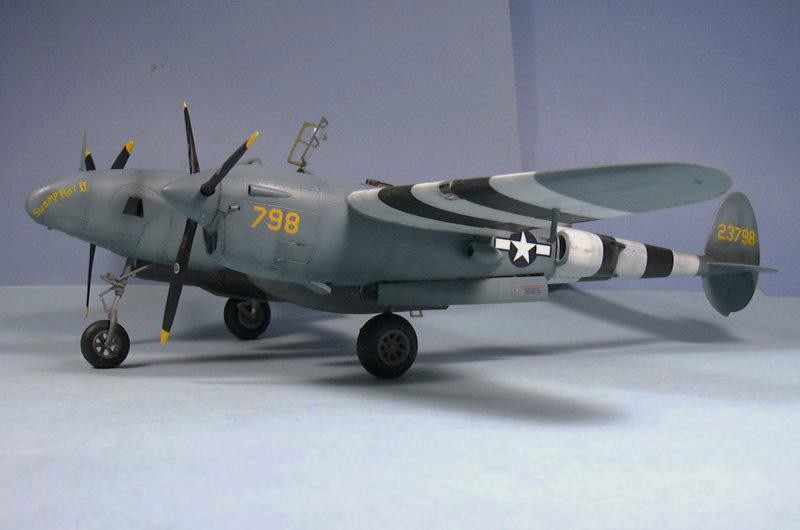

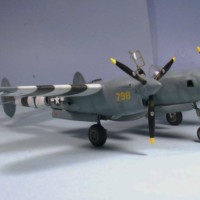
















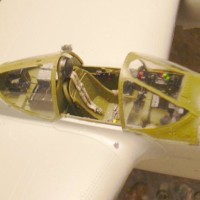



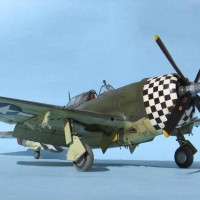
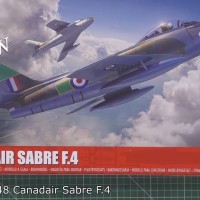
Great story and equally great lookin' build and pics...bet ya had to use a ton of nose weight on this, huh?
Particularly since I like to pose them tail low.
Probably used the nacelles as well, huh...?
indeed
Dunno if this'd be of any help to ya, but I've found that using #8 bird shot (really small shotgun lead pellets) work really well in those hard to fill areas when attempting to add necessary weight. They'll find every available nook, cranny and crevice and make adding [significant] weight to those areas requiring same simple & easy. Jus' sayin'...:)
Fabulous work and story. I also like the nose high/tail low look. Stunning.
Tom, great looking Lightning!
Great story and model, Tom. What kind of paint did you use? Is that the "Synthetic Haze" scheme? Looks lighter then RAF PRU blue.
Xtracrylix PRU blue with various inputs of ADC Grey (a blueish grey)
By the F-5E, AFAIK, the "Synthetic Haze" had been dropped.
Excellent story and build ! Tom do you have information on the Haze paint scheme that was applied. What would be the best colors to replicate the Haze scheme?
That's amazing work but I guess that's a norm for your projects. I remember building a P-38 when I was a kid, maybe an old Monogram kit, but it ended up nothing like as pristine as yours. Congrats all round.
I also like a great tale which this was.
Paul
Great story and a great build, thanks Tom, you made my day.
Extremely exciting to read.
I guess you met Major Childress for an interview?
Chili was a "regular" out at Chino 20 years ago.
Excellent! I'm kinda liking those recce schemes, and am gonna have to do one soon... And what's not to like about a P-38!
A great model to go with a great story.
Tom, I have to admit, this one nice looking F-5E. A very attractive scheme. Well done !
Amazing story, having travelled in the Loire valley it's incredible to think of this happening. The model looks great, too, although a little bit of info about the build wouldn't go amiss.
Sensational story again Tom, never stop! I've haven't ever felt the urge but even I am getting itchy for a P-38 seeing these builds!